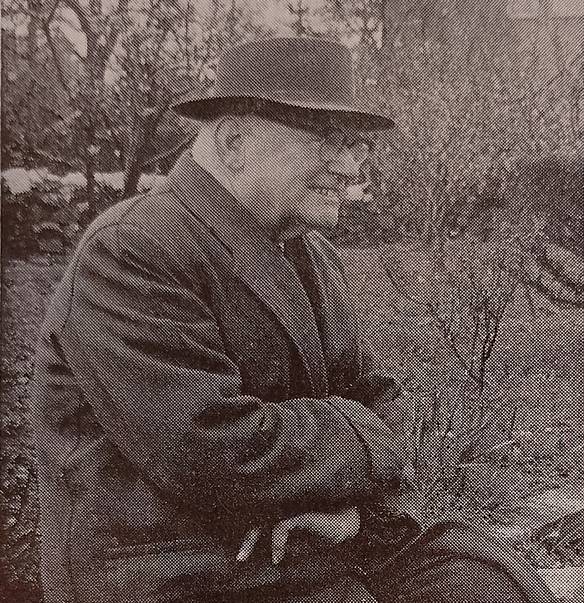
Born in 1888, his first article was published in "Model Engineer" magazine in 1903 when, at the age of fifteen he wrote a piece entitled "Reaming without a reamer", starting a series of contributions extending over nearly seventy years until his death in 1970.
He was apprenticed to Hawthorn Leslie in 1904 at five shillings a week, serving five years at their St.Peter's works in Newcastle. During his time there he won the Kings Prize for mechanical drawing, as well as the F.C.Marshall Memorial Trophy in 1908 and 1909.
Turning 21 years old - and three days out of his apprenticeship - in 1909 he joined Gleniffer at Paisley where he designed, built and tested their first petrol marine engine. A 4 cylinder, 20hp design, it was followed by others, including a twin cylinder generating set for Sir Harry Lauder's home near Dunoon.
In 1914 he joined Vickers Sons & Maxims, Sheffield, under Sebastian Ziani de Ferranti FRS, former president of the Institute of Electrical Engineers, working on experimental high superheat steam turbines. As Vickers' production switched over entirely to armament production, Ferranti left to rejoin the firm he had started in 1885. Tucker went with him, working for the company until his retirement in 1954.
The first record of one of his models is a mention in a 1918 edition of "Model Engineer" magazine where he mentions a high pressure O-gauge tank locomotive - little more is know of this early model.
In 1923 he drew up and built a 2 inch scale compound steam tractor, based on a Clayton & Shuttleworth - the drawings and photograph of his own engine were published at the time, the model going on to take a Silver Medal at the London Model Engineering Exhibition.
In 1935, LBSC featured a picture of "Wheezy Anna", Tucker's Fayette-inspired 2 1/2 inch gauge Pacific, built for the "Bramhall Light Railway", a 200 foot continuous line which he'd built in the garden (and which, incidentally, shared an identical lap record with Lawrence's own "Polar Route"!)
The railway was again featured in 1939, when LBSC described in highly complimentary terms the 2 1/2 inch gauge 2-6-2 + 2-6-2 Beyer-Garratt then under construction, complete with thermic syphon boiler.
1943 saw completion of a "Swindon-ised" version of LBSC's own "Miss Ten to Eight" design, turned out as a Great Western City class 4-4-0 which Tucker built with his son, Wilfrid.
In 1945 LBSC wrote up the Southern "Lord Nelson" 857, named "Lady Anna" by its builder (and subsequently "Lord Howe", after the prototype on which it was closely modelled). The engine was four cylinder, as per the prototype, but featured Holcroft valve gear. The engine ran exceptionally well, constructed to an impeccable standard which was becoming the builder's trademark, LBSC remarking of Tucker's work "The excellence of the workmanship put into these engines has seldom been equalled and never surpassed". A diligent record keeper, the builder logged 1697 hours work to complete the locomotive, with a further 385 hours on the tender.
All of which contributed to Lawrence's furious criticism of the London Exhibition judges who, in 1947, denied it the Championship Cup solely on the grounds of its non-prototypical valve gear, awarding a Silver Medal instead.
Quoted in the "Model Engineer" magazine many years later, Tucker confessed that, although pleased with his Silver Medals, the Championship Cup was what he truly wanted and so, settling down to his drawing board, he worked up the design for a 2-8-0 + 0-8-2 Garratt, based on a photograph published in the "Engineer" magazine. The original locomotive had been designed and built by the Vulcan Foundry, based on a pair of their "Liberation" chassis.
In 1954 the Duke of Edinburgh Challenge Trophy was established, remaining to this day the highest accolade for model engineering in the UK. To be eligible for consideration, a model has to have won either Silver or Gold Medals, or a Championship Cup; a Challenge Trophy winning model cannot then be entered for the award again. The same year, Tucker retired from Ferranti "to travel and build models".
In 1957 he entered his cup-winning Savery engine, winning the Duke of Edinburgh Trophy in that year, then again the following year with his Garratt.
In 1960 he was empanelled as an exhibition judge for the locomotive class, along with W.J.Hughes who judged road vehicles.
Now in his seventies - and with energy undimmed - he set about building a pair of models, both in 3 1/2 inch gauge. The first was a 4-6-2T, supplied by Kerr Stuart in 1910 for the three foot narrow gauge Londonderry and Lough Swilly Railway; a large model, the engine was completed in 1962.
The second was widely acknowledged to be his masterpiece - the Britannia "John Milton" (named "North Star" on completion, although carrying the number 70005). Built using BR works drawings, the builder made his own patterns, with many fabrications incorporated to replicate details on the full-size locomotive.
Another Garratt - the third he'd constructed - this time a 3 1/2 inch gauge freelance 0-4-4-0, influenced by Beyer Peacock design, was completed in 1966. Having sworn it would be his last, one final engine was to appear from the man's workshop, the magnificent 3 1/2 inch gauge Great Eastern "Decapod" which was to be his swan song.
Bill Tucker died in 1970, his obituary and tributes appearing in "Model Engineer" from W.J.Hughes, Don Young and K.N.Harris.





